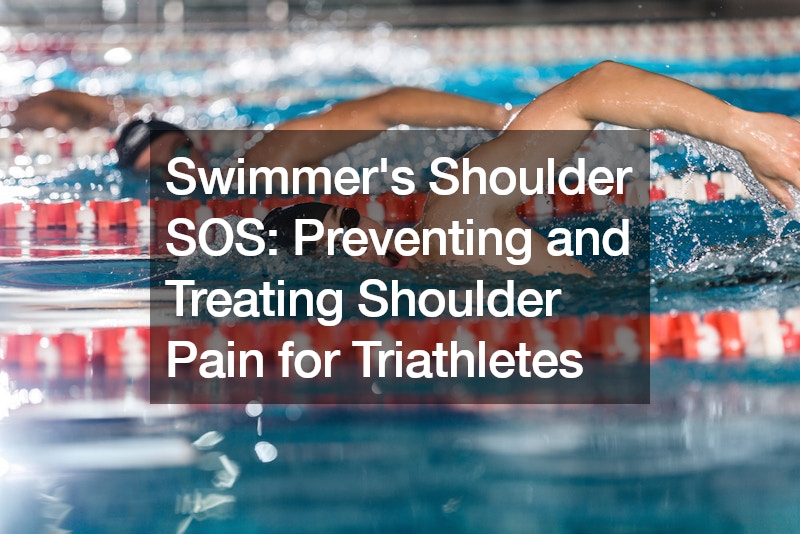
Swimmer’s Shoulder SOS: Preventing and Treating Shoulder Pain for Triathletes

Shoulder pain is a common ailment among swimmers and triathletes alike, often attributed to the repetitive motion and force exerted on the shoulders during swimming strokes. This condition, often referred to as “swimmer’s shoulder,” can be debilitating if left untreated, hindering performance and causing discomfort both in and out of the water. However, with proper understanding, preventative measures, and treatment strategies, athletes can effectively manage and alleviate shoulder pain to stay in top form for their training and competitions.
Understanding Swimmer’s Shoulder
Swimmer’s shoulder encompasses a range of shoulder injuries and conditions prevalent among swimmers and triathletes. It’s a multifactorial issue that can stem from overuse, poor technique, muscular imbalances, and structural abnormalities.
The repetitive nature of swimming strokes, particularly in the front crawl, places significant stress on the shoulder joint, making it susceptible to wear and tear over time.
At the core of addressing shoulder pain in swimmers is understanding the intricate anatomy of the shoulder joint. The shoulder is a complex structure with several joints and muscles working in tandem to facilitate movement. The glenohumeral joint, resembling a ball and socket, allows for a wide range of motion, making it susceptible to injuries if not properly maintained.
Common injuries associated with swimmer’s shoulder include rotator cuff tendinitis, impingement syndrome, biceps tendinitis, and shoulder instability. These injuries can manifest as pain, inflammation, weakness, and limited range of motion in the shoulder, affecting an athlete’s performance and overall well-being.
Factors Exacerbating Swimmer’s Shoulder
Swimmer’s shoulder is often exacerbated by factors such as inadequate warm-up, excessive training volume, sudden increases in intensity or duration, and insufficient recovery time between sessions. Ignoring early warning signs or pushing through discomfort can lead to chronic issues that may require more extensive treatment and rehabilitation.
In addition to physical factors, psychological and environmental factors can also contribute to swimmer’s Shoulder. Stress, anxiety, and poor coping mechanisms can increase muscle tension and affect movement patterns, potentially leading to imbalances and overuse injuries. Environmental factors such as water temperature, pool chemicals, and equipment can also impact shoulder health and should be considered in injury prevention strategies.
Recognizing the symptoms of swimmer’s shoulder and addressing them promptly is essential for preventing long-term damage and maintaining peak athletic performance. Athletes should pay attention to any persistent or worsening pain, stiffness, or weakness in the shoulder, as these could indicate an underlying issue that needs attention.
Technique Matters
One of the primary contributors to shoulder pain in swimmers is poor technique. Improper form during the recovery phase of the stroke, such as bringing the elbow too close to the ear, can result in unnecessary strain on the shoulder tendons. It’s crucial to maintain a relaxed and slightly wider recovery to alleviate this pressure. Additionally, improper hand entry and excessive strain on the shoulder during the pull phase can exacerbate shoulder issues. Focusing on technique and engaging larger muscle groups, like the latissimus dorsi, can help distribute the workload and reduce strain on the shoulder.
Posture and Activation
Beyond technique, posture plays a significant role in shoulder health. Spending extended periods hunched over, whether at a desk or on a bike, can lead to internal rotation of the shoulder joint, increasing the risk of injury during swimming. Proper activation of the scapula thoracic region through targeted exercises can help maintain optimal shoulder alignment and prevent unnecessary strain. Mobilizing the thoracic spine and engaging the muscles surrounding the shoulder blades are essential steps in improving posture and reducing the risk of shoulder pain.
Strengthening the Shoulder
Strength training is a vital component of preventing and treating shoulder pain in triathletes. Targeting key muscle groups, such as the rotator cuff muscles and the latissimus dorsi, can improve shoulder stability and support proper movement mechanics. Exercises like external and internal rotations with resistance bands, scapular retractions, and lat pulldowns can help strengthen the muscles surrounding the shoulder joint. Incorporating these exercises into a comprehensive strength and conditioning program can significantly reduce the risk of shoulder injuries.
Seeking Professional Guidance
While self-care and preventative measures are essential, consulting with a healthcare professional is crucial if shoulder pain persists or worsens. A qualified shoulder doctor can provide a comprehensive diagnosis, discuss appropriate treatment options, and offer personalized advice based on individual needs. In some cases, physical therapy, corticosteroid injections, or surgical intervention may be necessary to address underlying issues and alleviate persistent shoulder pain.
In Closing
Swimmer’s shoulder is a common yet manageable condition among triathletes. By prioritizing proper technique, maintaining optimal posture, and incorporating targeted strength training exercises, athletes can effectively prevent and treat shoulder pain. However, it’s essential to listen to your body and seek professional guidance if symptoms persist. With a proactive approach to shoulder health, triathletes can stay injury-free and perform at their best.
.





